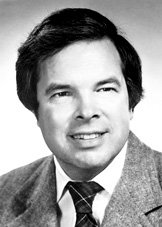維基百科,自由的百科全書
| 肯尼斯·G·威爾森 Kenneth G. Wilson | |
|---|---|
 | |
| 出生 | 1936年6月8日 麻薩諸塞州沃爾瑟姆 |
| 逝世 | 2013年6月15日(77歲) 緬因州索科 |
| 國籍 | |
| 母校 | 哈佛大學 加州理工學院 |
| 知名於 | 重正化群 相變 威爾森迴圈 |
| 獎項 | 沃爾夫物理學獎 (1980年) |
| 科學生涯 | |
| 研究領域 | 理論物理 |
| 機構 | 康乃爾大學 俄亥俄州立大學 |
| 博士導師 | 默里·蓋爾曼 |
肯尼斯·格德斯·威爾森(英語:Kenneth Geddes Wilson,1936年6月8日-2013年6月15日),美國理論物理學家,利用電腦研究粒子物理學的先驅。於1982年,他因為相變研究而獲得諾貝爾物理學獎,他的研究為不同現象的微妙本質提供了詳細解釋,這些現象包括冰的熔解及磁性的出現。這項研究是威爾森對重正化群基礎研究的一部份。他的同行都把他譽為理論物理學的偉人[1]。
威爾森對物理學主要的影響在於開發了一套詳細的尺度理論:系統的基本屬性和力隨量度的尺度而定。為了計算相變是如何產生的,他制定了一套「分而攻之」的策略,把每一個尺度分開考慮,然後巧妙地應用重正化群理論,把相鄰尺度的連結抽象化。這種做法為統計力學的相變和臨界現象提供了深切的瞭解,使精確的計算變得可能[2][3][4]。利用他所創的「自旋塊」技巧,他通過說明就解決了數個實在的數學樣式[5]。在固體物理學中,重整群有一個重要課題,叫近藤效應,而它就是由威爾森本人解決的[6]。
然後他延伸這些對尺度的理解,去解答量子場論與算子積展開性質的基礎問題[7][8][9][10][11][12],還有解釋重整群的物理意義[13] 。
他還開發了晶格規範理論,並成功把最初不能用電腦解決的強交互作用計算帶入了電腦,從而加深了科學家們對強子內夸克禁閉的理解[14]。他還釐清在這樣的一套晶格中的手徵性對稱,這項對稱是基本粒子交互作用的一項至關重要的特徵[15]。
Wikipedia
Kenneth Geddes "Ken" Wilson (June 8, 1936 – June 15, 2013) was an American theoretical physicist and a pioneer in leveraging computers for studying particle physics. He was awarded the 1982 Nobel Prize in Physics for his work on phase transitions—illuminating the subtle essence of phenomena like melting ice and emerging magnetism. It was embodied in his fundamental work on the renormalization group.
He went on to Harvard College at age 16, majoring in Mathematics and, on two occasions, ranked among the top five in the William Lowell Putnam Mathematical Competition. He was also a star on the athletics track, representing Harvard in the Mile. During his summer holidays he worked at the Woods Hole Oceanographic Institution. He earned his PhD from Caltech in 1961, studying under Murray Gell-Mann.[2] He did post-doc work at Harvard and CERN.[3]
He joined Cornell University in 1963 in the Department of Physics as a junior faculty member, becoming a full professor in 1970. He also did research at SLAC during this period.[4] In 1974, he became the James A. Weeks Professor of Physics at Cornell.
In 1982 he was awarded the Nobel Prize in Physics for his work on critical phenomena using the renormalization group.[5]
He was a co-winner of the Wolf Prize in physics in 1980, together with Michael E. Fisher and Leo Kadanoff. His other awards include the A.C. Eringen Medal, the Franklin Medal, the Boltzmann Medal, and the Dannie Heinemann Prize. He was elected a member of the National Academy of Science and a fellow of the American Academy of Arts and Science, both in 1975, and also was elected a member of the American Philosophical Society in 1984.[6]
In 1985, he was appointed as Cornell's Director of the Center for Theory and Simulation in Science and Engineering (now known as the Cornell Theory Center), one of five national supercomputer centers created by the National Science Foundation. In 1988, Wilson joined the faculty at The Ohio State University, moved to Gray, Maine in 1995. He continued his association with Ohio State University until he retired in 2008. Prior to his death, he was actively involved in research on physics education and was an early proponent of "active involvement" (i.e. Science by Inquiry) of K-12 students in science and math.
---
中文版: 全是贏家的學校:借鏡美國教改藍圖,台北:天下文化,1997,李遠哲序,賣出數萬本
沒有留言:
張貼留言